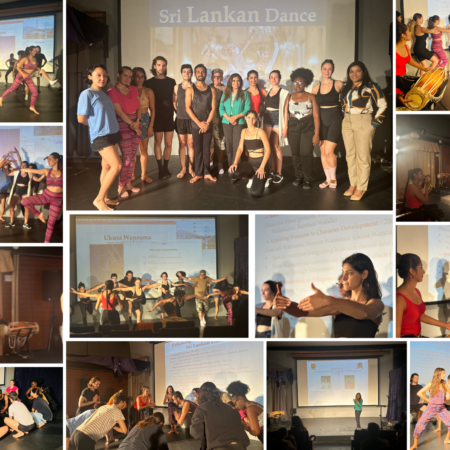It has stood there majestically for generations, depicting the Buddhist Culture, values and the beauty of Sri Lankan heritage.
The Dambulla Cave Temple is also known as the Golden Temple of Dambulla, situated in the central part of the country.
The site is spread tout in a vast area of 148 sq km to the east of Colombo and 72 sq km to the North of Kandy. It is the largest and the best preserved cave temple complex in Sri Lanka, apart from Aluviharaya in Matale.

The rock towers 160m over the surrounding plains and there are more than 80 documented caves in the surrounding area. Major attractions are spread over 5 caves, which contain statues and paintings. These statues and paintings are related to Gutama Buddha and his life.
These caves include a total of 153 Buddha statues, three statues of Sri Lankan kings and four statues of gods and goddesses. The latter include Vishnu and Ganesha. The murals cover an area of 2100 square metres and depictions on the walls of the caves include the temptation by the demon Mara, and Buddha’s first sermon.
It is said that pre- historic Sri Lankans would have lived in these cave complexes before the arrival of Buddhism in Sri Lanka as there are burial sites with human skeletons about 2700 years old in the area, at Ibbankatuwa near the Dambulla Cave Complexes.
The five caves vary in different sizes and magnificence. The caves, built at the base of a 150m high rock during the Anuradhapura and Polonnaruwa eras are the most impressive of the many cave temples found in Sri Lanka. One can access the site along the slope of the Dambulla rock, offering a clear, panoramic view of the surrounding flat lands, which include the rock fortress Sigiriya.
Another interesting incident which occurs is, when the dusk brings thousands of swooping swallows to the cave entrance, which is a rare sight.
The largest cave measures about 52m from east to west, and 23m from the entrance to the back, the cave is 7m tall at it’s highest point.
Hindu deities are also represented here, as are the kings Valagamba and Nissankamalla, and Ananda, the Buddha’s most devoted disciple.
The Dambulla cave monastery is still functional and remains the best preserved ancient edifice in Sri Lanka. The complex dates back from the third and second centuries BC, when it was already established as one of the largest and most important monastery.
Valagamba of Anuradhapura is thought to have turned these caves into a temple in the first century BC. Many other kings made their contribution later on, and by the 11th century, the caves became a major religious centre, and still are.
King Nissankamalla of Polonnaruwa gilded the caves and added about 70 Buddha statues in 1190. During the 18th century, the caves were restored and painted by the Kingdom of Kandy.
Such is the history of the ancient Dambulla cave temple, and in a society where places of worship, social and religious values are given less recognition, and where even the so called Buddhists fail to live according to Buddhist principles and are living a corrupted life, the work carried out by our ancient Sinhala kings to preserve the pride and beauty of our religious and cultural heritage is indeed astonishing and remarkable.
The temple itself depicts the beauty of Buddhism, and its teachings, and also being a religion which teaches to have compassion towards all living beings. It is mostly about following the four Brahma Viharas ,(four sublime states of mind ) Metta, Mudita, Karuna and Upekkha.
The Dambulla cave temple has been a subject of music and poetry as well, not only in the ancient times, but also in the modern era.
It’s spectacular beauty and religious importance have given much pleasure to thousands of devotees and visitors, both locally and internationally, the world heritage site being a major tourist attraction.
Sri Lanka is literally bound by the UNESCO protocol to protect this national treasure, and preserve it for the next generation and those to come, as it is also one of the UNESCO world heritages.
But according to the latest circumstances, there lies a question, if this ancient place of worship is under threat.
This was further clarified when Ms. Irina Bokova, UNESCO Director General, on her recent visit to Sri Lanka highlighted the situation of the UNESCO heritage site, and warned that it is also in the danger of being taken off from the UNESCO world heritages list.
Thus, this subject has aroused much interest in the public as well as the officials, because this is a fact which is not to be taken for granted. It has also raised the question if the relevant authorities had been aware of this matter.
Has any action been taken from the paintings and the interior being damaged further? Have new steps been implemented to protect other heritage sites too? The Daily Mirror inquired from Dr. Senarath Dissanayake, Director General of the Department of Archaeology what was the real situation behind the matter.
“We discussed about this issue at the UNESCO World Heritage Committee Meeting which was held recently. We explained about the construction work which was going on at the moment.
Earlier the idea was that the construction work of the new temple nearby was a threat to the world heritage site, but there is a considerable distance between the two temples.
The details may not have been properly communicated to the UNESCO Director General. There has not been any special issue. We are doing a lot of work on this World Heritage Site. We controlled the menace of insects which was being a threat and a menace to the frescoes inside the cave temple. And also we are taking the necessary steps to control the leakage of water inside the temple which may cause damage to the paintings. That was a big achievement, since these issues were being a threat to the World Heritage Site. In fact we have been able to bring the World Heritage Site to a better state than before.”
Prof. Prishantha Gunewardene , Director General of the Central Cultural Fund expressed his opinion as thus. “The Central Cultural Fund initiated the programme in 1991. The Central Cultural Fund was not in a position to carry out its duties there due to certain objections which came from the monastery. From that time onwards the Department of Archeology was working on the site.
In 2010, we drafted out a management plan including the protection of murals and paintings etc, but the monastery rejected. We had a better plan to restore the world heritage site to a better position. Right now the whole area is going through rapid modernization, and t has affected the universal value of the world heritage site.
We’re appealing to all stake holders to carry out the 2010 management plan. We are concerned about this matter, but since we do not have the responsibility of taking part, if the Department of Archeology take the necessary steps we can also give our support.
The UNESCO Special Mission had studied about the murals and paintings being under threat and had submitted a report. We have implemented a new project to conserve the murals and paintings in the region. Dambulla is the main hub’’ he said.
The Dambulla cave temple is a national treasure which should be attended to, since it does not only depict the beauty of our Buddhist culture and heritage, but also the expertise of our craftsman ship.
Ancient landmarks such as these show that Sri Lanka had rich social and a cultural background where our craftsmen had the opportunity of showcasing their talents and skills, proving that we were a great nation.
Whatever the circumstances might be, it is our duty to preserve and protect the cultural gifts that our ancestors had given to us, while shedding their blood, sweat and tears on this soil, for the betterment of the generations to come.






















